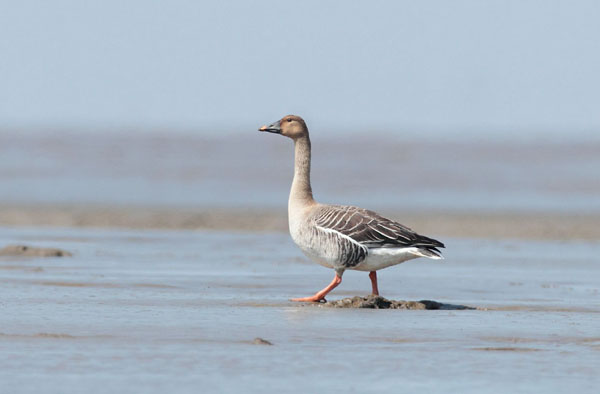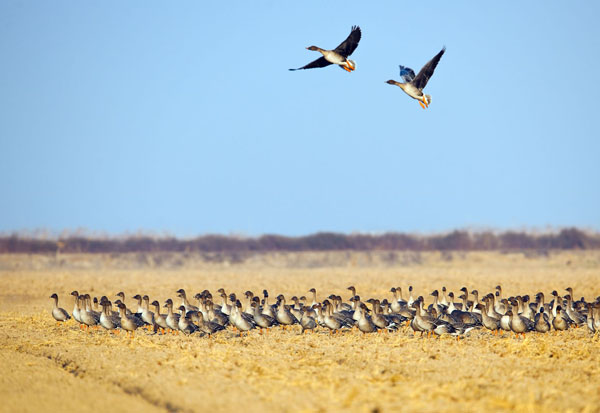Anser fabalis
IUCN
LCBasic Information
Scientific classification
- name:Anser fabalis
- Scientific Name:Wild goose, wheat goose,Anser fabalis,Bean goose
- Outline:Waterfowl
- Family:Anseriformes
Vital signs
- length:69-80cm
- Weight:About 3 kg
- lifetime:17years
Feature
Size and shape like a domestic goose.
Distribution and Habitat
The non-breeding period in China is found in the northwest, northeast, southwest, middle and lower reaches of the Yangtze River, southeast coastal areas and Taiwan Island. It breeds abroad in Northern Europe and Siberia near the Arctic in Taiga and forest swamp areas, and overwinters in southern Eurasia.
During the breeding period, it inhabits the Taiga forest and forest swamp areas near the Arctic region, and during the non-breeding period, it is mostly clustered in fields, lakes, lakes, swamps, rivers, reservoirs and other waters, and often lives in mixed groups with other large geese.
Appearance
The whole body is grayish brown with white and black stripes, white waist and tail undercover, chin throat and thorax color is lighter. The irises are reddish-brown, the beak black and the front end orange yellow, the tips black, and the feet orange red.
Details
Wild goose is a large goose, love to cluster, except the breeding period, often move in groups. Especially the migration season, often integrated tens, hundreds, or even thousands of large groups, led by an experienced head goose, the formation is constantly changing, sometimes into a "people" shape, sometimes into a "one" shape. The change of formation is related to the head bird that leads the flight, when it accelerates to fly fast, it becomes a "man" shape, and when it slows down, the formation becomes a "one" shape. I often live with geese. Sexual alert, not easy to approach, often 500 meters away from people take off. When sleeping at night, there are often one to several geese guards, stretching their necks to look around, and once they find something, they immediately issue an alarm call, and the geese immediately take off when they hear the sound, flying while singing, constantly circling over the habitat, until the danger has passed or it is determined that there is no danger before they fly back to their place. He often sleeps with his head in his side.

Feed mainly on plant foods. The breeding season mainly eats mosses, lichens, plant buds, young leaves, including reeds and some small shrubs, but also eats plant fruits and seeds and a small amount of animal food. During migration and wintering, it mainly feeds on grain seeds, beans, wheat seedlings, potatoes, sweet potatoes, plant buds, leaves and a small number of mollusks. Foraging is mostly on land. It usually feeds on farmland, grasslands, and swamps near its habitat, and sometimes flies to distant feeding grounds. Foraging in the morning and afternoon, more than noon in the lake on the water or the beach on the shore rest.
Bean geese are winter migratory birds in China and have not been reported to breed in China. They usually leave the breeding grounds from the end of August to the beginning of September every year, and arrive in China at the earliest in late September and early October, with a large number arriving in mid-late October and at the latest in early November. The migration takes place mostly at night, stopping during the day to rest and feed, and sometimes during the day, especially when the weather changes. During migration, groups range from dozens to more than a hundred individuals, and larger groups are often integrated in resting places, sometimes up to thousands of individuals. In early November 1992, we saw a flock of more than 1200 bean-geese in western Jilin Province. The time to leave China in spring is as early as early March to mid-March, a large number in late March to early April, and a small number of individuals have not left China at the latest from mid-April to the end of April. The migration in spring was smaller than that in autumn.
Bean goose is a male and a female system, the combination of the pair is more fixed. They usually nest together in pairs or groups. Breeding season May to July. The adult birds begin to nest soon after arriving at the breeding ground. Nests are built on the lakeside swamps of the tundra or on the banks and lakes near the remote Taiga, as well as on the beach rocks, in the river or on the island in the middle of the lake. The nest is mostly located in dry places such as hills and slopes, or in open ground in or near shrubs. The nest building is carried out by both male and female birds. First, the selected place is slightly stepped into a pit, and then the foundation is laid with hay and other dry plants as the bottom pad. The inner surface is then placed with feathers and the feather plucked from the female bird's own body.

The female birds incubate eggs alone, the male birds guard near the nest, under normal circumstances the female birds do not leave the nest, when in danger, it often extends its head to the ground, the whole body is tightly attached to the ground, hiding to avoid the enemy, only when the enemy is near the nest and other emergency situations to leave the nest, incubation period of 25-29 days. Chicks are early by nature, and chicks are often led by male and female parents after hatching activities on land or swamps near the water, and often avoid enemies or enter the water to escape by keeping close to the ground and lowering the height of the body in case of danger. Adult birds usually moult from mid-July to mid-August, during which time they basically lose the ability to fly and rely mainly on running on the ground. Young birds are sexually mature at 3 years, and a few show sexual demand at 2 years of age.
<span style="color: rgb(51, 51, 51); font-family: " Helvetica Neue" , Helvetica, Arial, " PingFang SC" , " Hiragino Sans GB" , " Microsoft YaHei" , " WenQuanYi Micro Hei" , sans-serif; text-indent: 28px; background-color: rgb(255, 255, 255);" The bean goose is a traditional game bird in China with a wide distribution and large population, but it has declined recently. According to the 1990 Asian midwinter Waterbird Survey organized by the International Waterfowl Research Bureau (IWRB), the number of overwintering goose populations in East Asia is estimated at 15,429, including 10,229 in China. According to a single sighting of 12 bean geese in Niuxinbao Grassland in western Jilin Province in November 1992, and the number of bean geese during the whole migration period and other migratory points, it is estimated that the population of bean geese in China can reach about 20,000.








